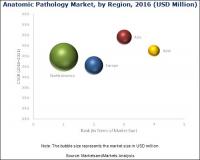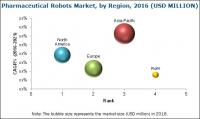(EMAILWIRE.COM, November 25, 2018 ) According to the new market research report Anatomic Pathology Market by Product & Service (Instruments (Tissue Processing Systems, Microtome), Consumables (Reagent & Antibodies), Histopathology, Cytopathology), Application (Disease Diagnosis, Drug Discovery & Development) - Forecasts to 2021", published by MarketsandMarkets, This report provides a detailed overview of the major drivers, restraints, challenges, opportunities, trends and strategies impacting the anatomic pathology market, along with revenue estimates & forecasts and market share analysis.
Dont miss out on business opportunities in Anatomic Pathology Market. Speak to our analyst and gain crucial industry insights that will help your business grow: http://bit.ly/2FAALCj
The global anatomic pathology market is expected to reach USD 21.9 Billion by 2021 from USD 16.2 Billion in 2016, at a CAGR of 6.1% from 2016 to 2021. The increasing prevalence of chronic diseases, growing aging population, and increasing healthcare expenditure are the major factors driving the growth of this market.
The growth of the anatomic pathology market can be attributed to the increasing prevalence of chronic diseases, growing aging population, and increasing healthcare expenditure.
Danaher Corporation (U.S.) accounted for the second-largest share 22% of the anatomic pathology products market in 2015. It focuses on collaborations and agreements to strengthen its position in the market. In March 2014, Leica Biosystems entered into an agreement with GNYHA Services (U.S), an acute care group purchasing and supply chain management organization. According to the terms of this agreement, Leica Biosystems offered its anatomical pathology products and innovations to GYNHA Services members to help them increase efficiencies and diagnostic confidence.
Browse and in-depth TOC on Anatomic Pathology Market
80 - Tables
32 - Figures
129 - Pages
View more detailed TOC @ https://www.marketsandmarkets.com/Market-Reports/anatomic-pathology-market-137323145.html
Major players in the anatomic pathology market include F. Hoffmann-La Roche AG (Switzerland), Thermo Fisher Scientific (U.S.), Danaher Corporation (U.S.), Agilent Technologies (U.S.), Sakura Finetechnical Co., Ltd. (Japan), Quest Diagnostics Incorporated (U.S.), Laboratory Corporation of America Holdings (U.S.), and NeoGenomics Laboratories, Inc. (U.S.).
Request for Free Sample Report @ http://bit.ly/2DTre7N
Browse Adjacent Markets @ Medical Devices Market Research Reports & Consulting
About MarketsandMarkets
MarketsandMarkets provides quantified B2B research on 30,000 high growth niche opportunities/threats which will impact 70% to 80% of worldwide companies revenues. Currently servicing 7500 customers worldwide including 80% of global Fortune 1000 companies as clients. Almost 75,000 top officers across eight industries worldwide approach MarketsandMarkets for their painpoints around revenues decisions.
Our 850 fulltime analyst and SMEs at MarketsandMarkets are tracking global high growth markets following the "Growth Engagement Model GEM". The GEM aims at proactive collaboration with the clients to identify new opportunities, identify most important customers, write "Attack, avoid and defend" strategies, identify sources of incremental revenues for both the company and its competitors. MarketsandMarkets now coming up with 1,500 MicroQuadrants (Positioning top players across leaders, emerging companies, innovators, strategic players) annually in high growth emerging segments. MarketsandMarkets is determined to benefit more than 10,000 companies this year for their revenue planning and help them take their innovations/disruptions early to the market by providing them research ahead of the curve.
MarketsandMarketss flagship competitive intelligence and market research platform, "Knowledge Store" connects over 200,000 markets and entire value chains for deeper understanding of the unmet insights along with market sizing and forecasts of niche markets.
Contact:
Mr. Shelly Singh
MarketsandMarkets INC.
630 Dundee Road
Suite 430
Northbrook, IL 60062
USA: 1-888-600-6441
Email: sales@marketsandmarkets.com
Research Insight: https://www.marketsandmarkets.com/ResearchInsight/anatomic-pathology-market.asp
Visit Our Website: https://www.marketsandmarkets.com
Mr. Shelly Singh
1-888-600-6441
sales@marketsandmarkets.com
Source: EmailWire.Com![]()
Dont miss out on business opportunities in Anatomic Pathology Market. Speak to our analyst and gain crucial industry insights that will help your business grow: http://bit.ly/2FAALCj
The global anatomic pathology market is expected to reach USD 21.9 Billion by 2021 from USD 16.2 Billion in 2016, at a CAGR of 6.1% from 2016 to 2021. The increasing prevalence of chronic diseases, growing aging population, and increasing healthcare expenditure are the major factors driving the growth of this market.
The growth of the anatomic pathology market can be attributed to the increasing prevalence of chronic diseases, growing aging population, and increasing healthcare expenditure.
Danaher Corporation (U.S.) accounted for the second-largest share 22% of the anatomic pathology products market in 2015. It focuses on collaborations and agreements to strengthen its position in the market. In March 2014, Leica Biosystems entered into an agreement with GNYHA Services (U.S), an acute care group purchasing and supply chain management organization. According to the terms of this agreement, Leica Biosystems offered its anatomical pathology products and innovations to GYNHA Services members to help them increase efficiencies and diagnostic confidence.
Browse and in-depth TOC on Anatomic Pathology Market
80 - Tables
32 - Figures
129 - Pages
View more detailed TOC @ https://www.marketsandmarkets.com/Market-Reports/anatomic-pathology-market-137323145.html
Major players in the anatomic pathology market include F. Hoffmann-La Roche AG (Switzerland), Thermo Fisher Scientific (U.S.), Danaher Corporation (U.S.), Agilent Technologies (U.S.), Sakura Finetechnical Co., Ltd. (Japan), Quest Diagnostics Incorporated (U.S.), Laboratory Corporation of America Holdings (U.S.), and NeoGenomics Laboratories, Inc. (U.S.).
Request for Free Sample Report @ http://bit.ly/2DTre7N
Browse Adjacent Markets @ Medical Devices Market Research Reports & Consulting
About MarketsandMarkets
MarketsandMarkets provides quantified B2B research on 30,000 high growth niche opportunities/threats which will impact 70% to 80% of worldwide companies revenues. Currently servicing 7500 customers worldwide including 80% of global Fortune 1000 companies as clients. Almost 75,000 top officers across eight industries worldwide approach MarketsandMarkets for their painpoints around revenues decisions.
Our 850 fulltime analyst and SMEs at MarketsandMarkets are tracking global high growth markets following the "Growth Engagement Model GEM". The GEM aims at proactive collaboration with the clients to identify new opportunities, identify most important customers, write "Attack, avoid and defend" strategies, identify sources of incremental revenues for both the company and its competitors. MarketsandMarkets now coming up with 1,500 MicroQuadrants (Positioning top players across leaders, emerging companies, innovators, strategic players) annually in high growth emerging segments. MarketsandMarkets is determined to benefit more than 10,000 companies this year for their revenue planning and help them take their innovations/disruptions early to the market by providing them research ahead of the curve.
MarketsandMarketss flagship competitive intelligence and market research platform, "Knowledge Store" connects over 200,000 markets and entire value chains for deeper understanding of the unmet insights along with market sizing and forecasts of niche markets.
Contact:
Mr. Shelly Singh
MarketsandMarkets INC.
630 Dundee Road
Suite 430
Northbrook, IL 60062
USA: 1-888-600-6441
Email: sales@marketsandmarkets.com
Research Insight: https://www.marketsandmarkets.com/ResearchInsight/anatomic-pathology-market.asp
Visit Our Website: https://www.marketsandmarkets.com
Mr. Shelly Singh
1-888-600-6441
sales@marketsandmarkets.com
Source: EmailWire.Com



























